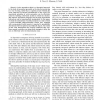Free Online Productivity Tools
i2Speak
i2Symbol
i2OCR
iTex2Img
iWeb2Print
iWeb2Shot
i2Type
iPdf2Split
iPdf2Merge
i2Bopomofo
i2Arabic
i2Style
i2Image
i2PDF
iLatex2Rtf
Sci2ools
CEC
2009
IEEE
2009
IEEE
Active categorical perception in an evolved anthropomorphic robotic arm
— Active perception refers to a theoretical approach to the study of perception grounded on the idea that perceiving is a way of acting, rather than a cognitive process whereby the brain constructs an internal representation of the world. The operational principles of active perception can be effectively tested by building robot-based models in which the relationship between perceptual categories and the body-environment interactions can be experimentally manipulated. In this paper, we study the mechanisms of tactile perception in a task in which a neuro-controlled anthropomorphic robotic arm, equipped with coarse-grained tactile sensors, is required to perceptually discriminate between spherical and ellipsoid objects. The results of this work demonstrate that evolved continuous time nonlinear neural controllers can bring forth strategies to allow the arm to effectively solve the discrimination task.
Active Perception | Artificial Intelligence | CEC 2009 | Coarse-grained Tactile Sensors | Tactile Perception |
| Added | 20 May 2010 |
| Updated | 20 May 2010 |
| Type | Conference |
| Year | 2009 |
| Where | CEC |
| Authors | Elio Tuci, Gianluca Massera, Stefano Nolfi |
Comments (0)

